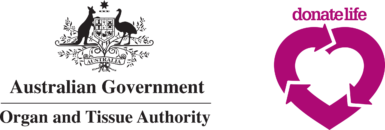Simplifying DonateLife’s LMS and boosting organ donation across the country

The Organ and Tissue Authority (OTA) delivers the Australian Government’s program to improve organ and tissue donation and transplantation rates nationwide, via its national DonateLife network.
Organ donation itself is a highly infrequent event. Due to clinical reasons, only around 2 per cent of people who die in hospital can become an organ donor. With donation possible in so few cases, and with so many patients needing a transplant, continuing to increase donation rates is vital.
A key factor is ensuring that the topic is raised in hospitals with grieving families by a trained donation specialist nurse or doctor, and that families are provided with high quality care during the donation process.
Evidence of the power of effective training within the OTA is clear. In 2018, nearly 8 out of 10 Australian families agreed to their loved one becoming an organ donor when they were supported by a trained donation specialist doctor or nurse. This dropped to fewer than 5 out of 10 when there was no trained specialist involved.
The brief
The OTA approached Janison in 2015 because it wanted to improve the consistency of its professional training and be able to offer resources on-demand across the country.
To do this, it needed a centrally-hosted eLearning portal. Fewer than 30 staff work at the OTA, engaging a DonateLife network of about 300 people in 98 hospitals across Australia. The OTA funds the training for these donation specialists, doctors and nurses who are involved in conversations with families.
The OTA wanted:
- a national solution with functionality to make it easier to monitor team members’ training down to individual level, across all states.
- to make it easier to monitor state agency training KPIs.
- to be able to host multimedia modules in a website environment, including podcasts, videos and written training.
- a solution that would grow easily with the organisation’s program and which wouldn’t restrict it from a licensing perspective.
The challenge
DonateLife’s members are spread out across Australia, making it difficult to communicate across agencies and states, as well as track individuals’ training. Until approaching Janison, the OTA was relying on spreadsheets to accomplish this.
The OTA’s training is highly specialised and needs to build delicate communication skills. Amanda Bell, Director of Clinical Programs at the OTA, said: “Organ donation occurs at an extremely traumatic time for families – often following unexpected death – and achieving it is a medically complex process.
“Our professionals receive specialist training to be able to support families because the donation has to take place generally quite quickly following a person’s death, so a lot of our training focus is around communication.”
Modules focus on how to empower families to reach a decision that they will be comfortable with for years to come. Staff need to simultaneously convey the rareness of the opportunity, yet connect to the family’s loved one.
“Families are experiencing such trauma in that moment, but we don’t want them to look back and ask, ‘Why wasn’t I asked about donation?’. So, it’s a very key conversation that our professionals have to have.”
In 2018, of 78,525 deaths that occurred in hospitals, 1,211 potential donors were identified. Requests to families for donation were made in 1,118 cases, with 716 consenting. Of those, in 162 cases donation didn’t proceed for clinical reasons. But the remaining 554 donations saved and transformed the lives of 1,544 organ transplant recipients and their families.
The OTA is a statutory authority of the Australian Government and needed to make careful choices with how it channels its training budget. It wanted to focus most of its budget on creating modules and resources, rather than having to service the platform and IT infrastructure to deliver it.
Our solution
Janison focused on the overall platform and making it easy to administer and navigate, and the OTA partnered with various content providers to develop the eLearning modules.
“You don’t want people spending ages trying to find the content they need,” said a Janison project spokesman. “The modules themselves cover a very sensitive subject. The content needs to be put front and centre, and presented in a very clean, clear way.”
Designing the platform on the cloud meant it could scale and be updated easily and cost-effectively. “The original vision was to get content out to as many people as possible and make that easy, and make it easy for the OTA to grow the site as their program grew.”
Consolidated training
The OTA’s platform consolidates its training programs into a one-stop shop for guidelines, education and training. It has 1,877 active users Australia-wide, including OTA staff, DonateLife Network staff in hospitals and agencies, and broader hospital intensive care and emergency department staff who participate in training.
The platform hosts bespoke content and e-modules, including a podcast series and videos that deliver specialised training, some of which used to only be available face-to-face. These include role plays of the complicated family conversation around organ and tissue donation.
Importantly, there’s also the OTA’s national orientation program for the DonateLife network which needs to be delivered to a variety of professionals. “We designed the course to clearly describe the national program and how a new DonateLife team member’s role fits within that bigger picture,” said Amanda.
“A lot of the staff in DonateLife work in a normal ICU role within a hospital but also some dedicated time within the network’s specialist role. Our platform enables us to deliver a variety of training to staff across different hospitals.”
Administration made easy
Reporting tools and administrator dashboards solve challenges by automating the task of managing specialised training across multiple groups and hospital roles.
Amanda said: “The ability to assign training based on group type is one of the most useful features. We’ve used the platform’s functionality to set up different group types so we can deliver enrolments. Once they attend one module, they’re assigned to a group and then they get training delivered automatically that’s specific to their needs.”
Notification tools that unite disparate teams
Notification features make it easier to communicate quickly across multiple groups, Amanda said, adding: “We recently did some redesign work on the platform and added new content, so just having that ability to reach everybody with the press of the button is excellent. We can tell them ‘check out what’s new’, and where to find it.”
User profile tools
The platform’s profiling tools simplify the task of administering training for a national program. Amanda said: “We can assign administrator rights to people based in the state agencies – being able to do that has really cut back the workload and increased the accuracy of user profiles.
“We’re able to create new profiles when people join the network with different group identifiers and access. We don’t necessarily know when staff come on board or leave individual hospitals, so giving that administrator right enables states to keep their own systems up-to-date at a more granular level.
“They can then update the staff profiles, activate them and report on all their own staff training.”
Customised reporting
Reporting tools ease the management workload for the OTA at state level. “The states can use the system to generate reports, plus look at activity at that local level. This enables them to pull information or filter it in whichever way they need.”
The result
The Janison Academy platform continues to grow as the OTA’s work grows, with 1,877 active users across the country, and approximately 325 new users joining per year.
The OTA says that the capability of the platform has been extremely useful in allowing it to be dynamic and change with the new directions that the organisation takes to its learning and development. This is demonstrated by the impressive take-up among current active users: 98 per cent have attended the OTA’s core training workshop and 53 per cent have completed its more advanced practical workshop.
Amanda said: “The feedback we receive has also been very positive, especially in regards to our new learning modules which, because of the capability of the system, have been able to be targeted at our DonateLife staff.
“The modules were completed by 27 per cent of the targeted group within one month of going live. This for us is a big win, because these are the people who are on the ground having the important conversations with families to help them make an important decision and any help we can provide them in this important task is fantastic and this platform lets us do that.”
The modules were completed by 27 per cent of the targeted group within one month of going live. This is a big win, because these are the people who are on the ground having the important conversations with families.
Amanda Bell
Director of Clinical Programs, Organ and Tissue Authority
Statistics and key milestones
1,877
active users Australia-wide
98%
of users have attended the OTA's core training workshop
325
new users joining every year
Want to learn more about our tailored solutions?
Chat to one of our assessment or learning consultants today.
or call us on 1300 857 687 (Australia) or +61 2 6652 9850 (International)
